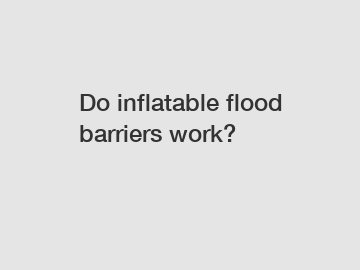Do inflatable flood barriers work?
Do inflatable flood barriers work?
Inflatable flood barriers, which are designed to provide temporary protection against rising waters, have gained popularity in recent years. Many people question their effectiveness and whether they can truly prevent flood damage. In this article, we will answer the question "Do inflatable flood barriers work?" and explore the evidence behind their effectiveness, their significance, and the potential impacts they can have.
Evidence of effectiveness.

Numerous studies and real-life scenarios have demonstrated the efficacy of inflatable flood barriers. One notable example is the use of such barriers during the devastating floods in New Orleans caused by Hurricane Katrina in 2005. The flood barriers erected around critical infrastructures, such as pumping stations and power plants, successfully withstood the onslaught of water and prevented significant damage.
Furthermore, controlled laboratory experiments have tested the durability and reliability of inflatable flood barriers. These tests involve subjecting the barriers to different water pressure levels and monitoring how well they perform in holding back the flow. The results consistently show that these barriers can effectively withstand high water pressure, giving weight to their claims of flood prevention.
Significance and impact.
The significance of inflatable flood barriers lies in their ability to provide immediate protection in flood-prone areas. Unlike permanent flood defenses, which can take years to construct, inflatable barriers can be deployed rapidly when floodwaters begin to rise. This agility allows for a quick response to emergencies, safeguarding both lives and properties.
Moreover, inflatable flood barriers are more cost-effective compared to permanent structures. Constructing traditional dikes or levees can be a costly endeavor, requiring extensive planning, construction, and maintenance. In contrast, inflatable barriers require relatively minimal investment and can be reused in multiple flood events. This affordability makes them a viable option, particularly for regions with limited financial resources to invest in permanent infrastructure.
Additionally, the flexible nature of inflatable flood barriers allows for customization and adaptability. They can be easily adjusted to fit different terrains and can be expanded or contracted depending on the flood risk levels. This versatility makes them suitable for various locations, including urban areas and remote regions, empowering communities to take proactive measures against flooding.
However, it is important to note that inflatable flood barriers are not a standalone solution. They should be considered as part of a comprehensive flood management strategy that includes early warning systems, land use planning, and community education. Flooding is a complex issue that requires a multi-faceted approach to mitigate its impacts effectively.
In conclusion, inflatable flood barriers do work and have proven their effectiveness in numerous real-life situations and controlled experiments. Their significance lies in their immediate deployment, affordability, and adaptability. Nonetheless, they should be viewed as a complementary measure within a broader flood management framework. By incorporating these barriers into existing strategies, we can better protect vulnerable communities and minimize the damage caused by flooding.
If you want to learn more, please visit our website water inflatable rubber dam, custom Melting Deicing Device, Stormwater Isolation Dam.


